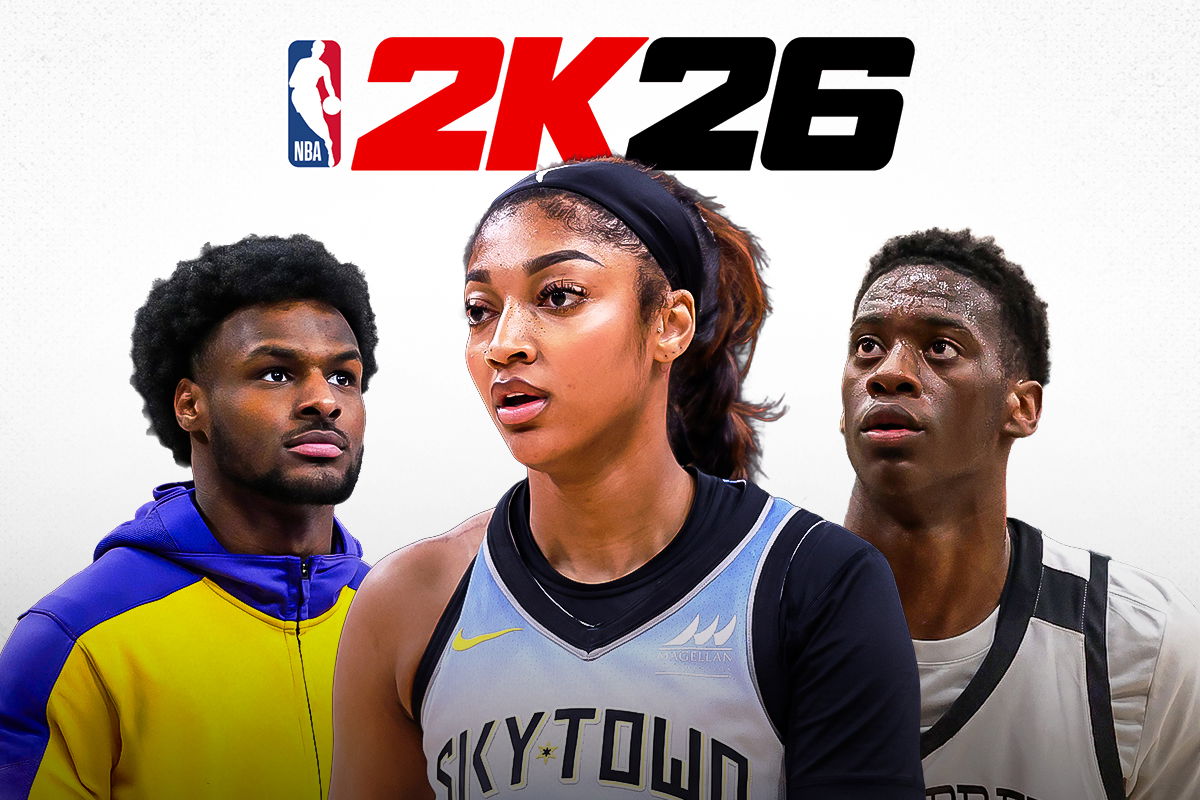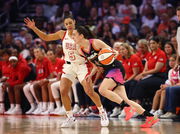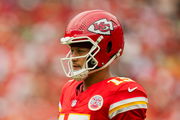

You thought the big news would be EA reviving its classic college basketball franchise, right? Well, they’re out. And the company everyone loves to roast “2K” is the one actually bringing college hoops back. Yep. The same 2K that was the first to charge $70 for NBA 2K21 back in 2020 and has been criticized for stuffing its games with microtransactions at every turn, is suddenly the unlikely guardian of college basketball nostalgia.
Watch What’s Trending Now!
Here’s the backstory: On June 30, EA teased fans with a basketball branded with their logo, captioned, “Bring the Madness. Let’s run it back. #CBB #ItsInTheGame.” It was a long-awaited return, seven years since NBA Live 19 and even longer since NCAA Basketball 2010. Fans immediately suggested 2K take over, and the company playfully replied, “The campus has been quiet for too long 😏,” confirming it was exploring ways to revive college hoops.
Behind the scenes, a memo reported by Matt Brown revealed that following the success of EA Sports College Football 25, the College Licensing Company (CLC) had solicited proposals for a college basketball game, ultimately recommending EA Sports due to its football revival success. The plan: a 2028 release with 730+ Division I men’s and women’s teams. But despite all plans being in place, EA stepped back, leaving 2K as the unexpected frontrunner. So, how is 2K approaching it?
ADVERTISEMENT
Here’s how 2K took the college court
2K’s approach isn’t a separate title; it’s weaving college programs directly into NBA 2K, transforming the flagship basketball sim into a recruiting showcase.
On September 4, during NBA 2K26 launch week, 2K fired off a post on X: “It’s NBA 2K26 launch week! It seems like a good time to share even MORE incredible news about the future of basketball at 2K.” It seems college basketball is back, but not in the way fans pictured. Instead of a full game, it’s debuting as a bonus mode.
ADVERTISEMENT
2K’s plan for a college basketball game:
• CBB added into NBA 2K (not a standalone CBB game)
• Schools begin getting added to the game in 2026
• 100+ schools featured (far from the 361 teams in D1)EA… we owe you an apology. pic.twitter.com/8aIAMKeuWX
— College Basketball Report (@CBKReport) September 5, 2025
At launch, over 100 schools will be available, featuring the biggest powerhouses: Duke, Kansas, Kentucky, UCLA, along with a few Cinderella programs to mix it up. Not every single one of the 361 Division I programs, but enough to feel legit. So why not the full roster?
ADVERTISEMENT
Because of licensing realities. Covering every single school would be insanely expensive and a total legal headache. Plus, most fans don’t really care about the smaller programs. That’s why 2K’s strategy is simple: focus on the biggest schools first, prove the model works, and gradually expand the lineup over time. Instead of creating an entirely new standalone game, this will launch as DLC in MyTeam mode: a 5v5 tournament-style format. It will debut in early 2026, with hints at much bigger expansions coming in 2027 and beyond.
Top Stories
“RIP”: Prayers Pour In as Tom Brady’s Raiders Struck by Tragedy

Footage Surfaces of Florida Police Arresting NASCAR Veteran Over Disturbing Public Misbehavior

“Rest in Peace”: Prayers Pour In From Dan Marino as Dolphins Legend Mourns Tragedy in South Florida Football

Caitlin Clark Shows Concerning Signs vs. Kelsey Plum During USA Camp Debut, per National Reporter

“NFL Was Crying”: Maxx Crosby Says League Forced Him to Remove Shoes Honoring His Daughter

Chiefs QB Patrick Mahomes Loses Faith in Kansas City With Cowboys Decision as FOX Host Calls Out Clark Hunt’s Ownership

The licensing battle that benched EA’s college hoops plans
EA had a bold plan: release a full game in 2028 with all Division I men’s and women’s programs, complete with modes like Ultimate Team, Dynasty, Road to Glory, and playoff tournaments. But because too many schools signed licensing deals with 2K, EA couldn’t get the exclusive rights it wanted. Without enough schools on board, the project wasn’t viable, and EA quietly stepped back.
ADVERTISEMENT
As Sean O’Brien, EA Sports’ VP of Commercial Partnerships and Licensing, put it: “Given there are some schools choosing to accept the 2K Sports proposal for inclusion in NBA 2K, the offer to be included in a college basketball video game will unfortunately have to be rescinded.” So EA is out, now what does that mean for fans? For the schools, 2K was a clear choice.
Why did schools say yes to 2K?
- Licensing deals directly pay programs.
- NBA 2K gives programs exposure to millions.
- Partnerships aren’t exclusive, so schools can still explore other opportunities.
ADVERTISEMENT
But the real story is the players themselves…
The new pay-to-play economy
The real game-changer is that players finally get paid to appear. Name, Image, and Likeness rules mean payout checks aren’t just for schools anymore. In College Football 25, 26 athletes who opted in earned at least $1,500 plus a Deluxe Edition copy, more than double the previous year’s $600. College basketball is expected to follow the same model. That makes 2K’s integration not just a nostalgia play, but a real slice of the NIL marketplace.
ADVERTISEMENT
This ties directly into EA’s broader sports strategy. Madden NFL 24 hit record net bookings with a 6% year-over-year increase, while EA SPORTS FC thrived, powered by Ultimate Team microtransactions, which made up ~73% of EA’s total revenue in 2024. Looking ahead, EA projects $7.6-8 billion in net bookings for FY2026, fueled by Madden, EA SPORTS FC, Battlefield, Skate, and more. But with 2K quietly seizing the college hoops stage, who will capture the next generation of fans?
How does EA make money and pay schools?
Microtransactions: In CFUT, players buy card packs, skins, and equipment to enhance their teams. Probabilities are displayed for transparency, and historically, pack sales have been a major revenue driver – 30% of EA’s digital sales as early as 2016.
Licensing Payouts: NCAA schools are compensated for logos, team names, and likenesses. By College Football 26, royalties are tied to how often teams are selected, so popular schools earn more. Pick your favorite, and the school benefits directly.
ADVERTISEMENT
Meanwhile, 2K quietly positions itself as the new king of college hoops, but how does it impact recruiting and fan awareness?
The game that puts hidden programs on the map
NBA 2K has quietly become a recruitment and awareness tool. By reintroducing college basketball teams from bluebloods to mid-majors, young fans get to play as schools they might never have heard of, like Gonzaga, Creighton, or San Diego State. And once they pick a team, they remember it.
ADVERTISEMENT
Why it matters:
Exposure: Smaller programs get screen time alongside Duke or Kentucky
Brand recognition: Logos, colors, and players stick in players’ minds.
The Pipeline Effect: A teenager doesn’t just watch their dream school anymore; they play as it, and that can shape real recruiting choices.
Global reach: Players worldwide can discover U.S. college teams, spreading awareness far beyond campus.
Can digital exposure really turn into real-world growth? Yes. Need proof?
It works like FIFA for smaller football clubs. By including lesser-known teams, FIFA has grown global fanbases, boosted visibility, and even helped with sponsorship and recruitment. For instance, MLS teams promoting through digital platforms resulted in a 25% increase in social media engagement across major platforms like Instagram, Facebook, TikTok, and YouTube
Even lower-tier clubs can now step into the spotlight. Take Stevenage FC, a small League Two club, which in 2019 partnered with Burger King. The fast-food giant sponsored the team’s kit, which then appeared in FIFA 20. Players were encouraged to pick Stevenage, score goals, and share clips online for rewards. The campaign generated up to 1.2 billion media impressions globally, with an earned marketing value of $2.5 million and over 2.5 million media interactions.
The ripple effect goes beyond fans. Small clubs have reported significant increases in sponsorship inquiries, thanks to digital visibility. FIFA turned virtual play into real-world growth, and now, NBA 2K is following the same blueprint for U.S. college basketball programs. With EA out and 2K in, college hoops’ new frontier is digital, where NIL payouts, recruiting clout, and player-driven content will shape tomorrow’s stars. Next up: even bigger NIL x esports crossovers, with athletes streaming as their own avatars. Bottom line? The future of college basketball is less sneakers on hardwood, more thumbs on controllers. Game on.
ADVERTISEMENT
ADVERTISEMENT
ADVERTISEMENT

